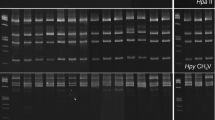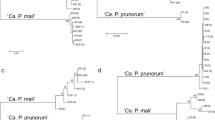Abstract
In several European countries apple trees are affected by apple proliferation disease, which is usually associated with the presence of ‘Candidatus Phytoplasma mali’. During 2010, samples from several apple trees displaying proliferation symptoms were collected throughout the Czech Republic to verify identity of phytoplasmas detected in association with the disease. The majority of the 74 apple trees examined using molecular tools were positive for ‘Ca. P. mali’ presence. The 16S–23S ribosomal genes, the ribosomal protein genes and the nitroreductase and rhodonase like genes were then studied to verify phytoplasma strain variability on multigenic bases. Two RFLP profiles and correspondingly two genetic lineages were found in the PCR-amplified fragments covering the 16S–23S rDNA spacer region. ‘Ca. P. mali’ strains belonging to rpX-A subgroup were identified in the majority of the apple tree sampled, whereas phytoplasmas belonging to the rpX-B subgroup were distributed sporadically. The apple proliferation subtypes AP-15 and AT-2 exhibited nearly equal occurrence; the AT-1 subtype and a mixture of the two or all three of the AP subtypes were infrequently found. The PCR/RFLP results were confirmed by nucleotide sequence analyses of selected ‘Ca. P. mali’ strains.




Similar content being viewed by others
References
Bertaccini, A., Carraro, L., Davies, D., Laimer da Camara Machado, M., Martini, M., Paltrinieri, S., et al. (2000). Micropropagation of a collection of phytoplasma strains in periwinkle and other host plants. In Proceedings of the 13th International Congress of the International Organization for Mycoplasmology, Fukuoka, Japan, 14–19 July 2000, p. 101.
Bertaccini, A., Davies, D., Fialová, R., Fránová, J., Karešová, R., Martini, et al. (2001). A molecular survey to identify phytoplasmas associated with apple trees showing different disease symptoms. Acta Horticulturae, 550, 371–376.
Bertaccini, A., Vibio, M., Janečková, M., & Fránová—Honetšlegrová, J. (1998). Molecular detection of phytoplasmas in apple with rubbery wood symptoms. Acta Horticulturae, 472, 693–700.
Bertaccini, A., Paltrinieri, S., Martini, M., Fisichella, M., Ermacora, P., Fontanari, M., et al. (2008). Comparison of different detection systems for apple proliferation phytoplasmas in Trentino (North Italy). Acta Horticulturae, 781, 453–458.
Blattný, C., Jr., Seidl, V., & Erbenová, M. (1963). The apple proliferation of various sorts and possible strain differentiation of viruses. Proceedings 5th European Symposium on Fruit Tree Virus Diseases. Phytopathologia Meditteranea, 2, 119–123.
Blažek, J., Vávra, R., & Kučerová, J. (2005). Analysis concerning the rapid spread of apple proliferation phytoplasmas in a breeding orchard of apple seedlings. Horticultural Science, 32(2), 43–49.
Blystad, D-R., Toppe, B., Holst, M. A., & Brurberg, M. B. (2012). Survey for apple proliferation in orchards close to nurseries in Norway in 2011. In Book of Abstracts of the 22nd International Conference on Virus and Other Graft Transmissible Diseases of Fruit Crops, Rome, Italy, 3–8 June 2012, p. 98.
Brčák, J., Králík, O., & Seidl, V. (1972). Mycoplasmas in apple trees infected with the proliferation disease. Biologia Plantarum, 14(6), 427–429.
Brzin, J., Ermarcora, P., Osler, R., Loi, N., Ravnikar, M., & Petrovič, N. (2003). Detection of apple proliferation phytoplasma by ELISA and PCR in growing and dormant apple trees. Journal of Plant Disease and Protection, 110, 476–483.
Cainelli, C., Bisognin, C., Vindimian, M. E., & Grando, M. S. (2004). Genetic variability of AP phytoplasmas detected in the apple growing area of Trentino (North Italy). Acta Horticulturae, 657, 425–430.
Cainelli, C., & Grando, M. S. (2005). Population structure and dynamics of apple proliferation in Trentino. Petria, 15, 69–71.
Casati, P., Quaglino, F., Tedeschi, R., Spiga, M. F., Alma, A., Spadone, P., et al. (2010). Identification and molecular characterization of ‘Candidatus Phytoplasma mali’ isolates in North-western Italy. Journal of Phytopathology, 158, 81–87.
Casati, P., Quaglino, F., Stern, A. R., Tedeschi, R., Alma, A., & Bianco, P. A. (2011). Multiple gene analyses reveal extensive genetic diversity among ‘Candidatus Phytoplasma mali’ populations. Annals of Applied Biology, 158, 257–266.
Davis, R. E., & Lee, I.-M. (1993). Cluster-specific polymerase chain reaction amplification of 16S rDNA sequences for detection and identification of mycoplasmalike organisms. Phytopathology, 83, 10081010.
Deng, S., & Hiruki, C. (1991). Amplification of 16S rRNA genes from culturable and non-culturable mollicute. Journal of Microbiological Methods, 14, 53–61.
Doyle, J. J., & Doyle, J. L. (1990). Isolation of plant DNA from fresh tissue. Focus, 12, 13–15.
Duduk, B., Calari, A., Paltrinieri, S., Duduk, N., & Bertaccini, A. (2009). Multigene analysis for differentiation of aster yellows phytoplasmas infecting carrots in Serbia. Annals of Applied Biology, 154(2), 219–229.
Fialová, R., Navrátil, M., & Válová, P. (2003). Phytoplasma occurrence in apple trees in the Czech Republic. Plant Protection Science, 39, 7–12.
Fránová, J., Petrzik, K., Růžičková, M., Paprštein, F., & Kučerová, J. (2008). Molecular identification of phytoplasmas in cultivar collection and production plantations of apple and pear trees in the Czech Republic. Acta Horticulturae, 781, 359–368.
Frisinghelli, C., Delaiti, L., Grando, M. S., Forti, D., & Vidimian, M. E. (2000). Cacopsylla costalis (Flor 1861) as a vector of apple proliferation in Trentino. Journal of Phytopathology, 148, 425–431.
Gibb, K. S., Padovan, A. C., & Mogen, B. D. (1995). Studies on sweet potato little-leaf phytoplasma detected in sweet potato and other plant species growing in northern Australia. Phytopathology, 85, 169–174.
Gundersen, D. E., & Lee, I.-M. (1996). Ultrasensitive detection of phytoplasmas by nested-PCR assays using two universal primer pairs. Phytopathologia Mediterranea, 35, 144–151.
Jarausch, W., Saillard, C., Dosba, F., & Bové, J. M. (1994). Differentiation of mycoplasmalike organisms (MLOs) in European fruit trees by PCR using specific primers derived from the sequence of a chromosomal fragment of the apple proliferation MLO. Applied and Environmental Microbiology, 60, 2916–2923.
Jarausch, W., Saillard, C., Helliot, B., Garnier, M., & Dosba, F. (2000). Genetic variability of apple proliferation phytoplasmas as determined by PCR-RFLP and sequencing of a non-ribosomal fragment. Molecular Cell Probes, 14, 17–24.
Jarausch, B., Schwind, N., Jarausch, W., & Krczal, G. (2004). Analysis of the distribution of apple proliferation phytoplasma subtypes in a local fruit growing region in Southwest Germany. Acta Horticulturae, 657, 421–424.
Jomantiene, R., Davis, R. E., Valiunas, D., & Alminaite, A. (2002). New group 16SrIII phytoplasma lineages in Lithuania exhibit rRNA interoperon sequence heterogenity. European Journal of Plant Pathology, 108, 507–517.
Kučerová, J., Karešová, R., Erbenová, M., & Vacková, H. (2005). First results from monitoring dynamic of occurrence apple proliferation (AP) during vegetation season. Vědecké práce ovocnářské, 19, 97–103.
Lee, I.-M., Gundersen, D. E., Hammond, R. W., & Davis, R. E. (1994). Use of mycoplasmalike organism (MLO) group-specific oligonucleotide primers for nested-PCR assays to detect mixed-MLO infections in a single host plant. Phytopathology, 84, 559–566.
Lee, I.-M., Bertaccini, A., Vibio, M., & Gundersen, D. E. (1995). Detection of multiple phytoplasmas in perennial fruit trees with decline symptoms in Italy. Phytopathology, 85, 728–735.
Lee, I.-M., Gundersen-Rindal, D. E., Davis, R. E., & Bartoszyk, I. M. (1998). Revised classification scheme of phytoplasmas based on RFLP analyses of 16S rRNA and ribosomal protein gene sequences. International Journal of Systematic Bacteriology, 48, 1153–1169.
Lee, I.-M., Gundersen-Rindal, D. E., Davis, R. E., Bottner, K. D., Marcone, C., & Seemûller, E. (2004). ‘Candidatus Phytoplasma asteris’, a novel phytoplasma taxon associated with aster yellows and related diseases. International Journal of Systematic and Evolutionary Microbiology, 54, 1037–1048.
Liefting, L. W., Andersen, M. T., Beever, R. E., Gardner, R. C., & Forster, R. L. (1996). Sequence heterogeneity in the two 16S rRNA genes of Phormium yellow leaf phytoplasma. Applied and Environmental Microbiology, 62, 3133–3139.
Loi, N., Carraro, L., Musseti, R., Firrao, G., & Osler, R. (1995). Apple proliferation epidemics detected in scab-resistant apple trees. Journal of Phytopathology, 143, 581–584.
Lorenz, K. H., Schneider, B., Ahrens, U., & Seemûller, E. (1995). Detection of apple proliferation and pear decline phytoplasmas by PCR amplification of ribosomal and nonribosomal DNA. Phytopathology, 85, 771–776.
Martini, M., Ermarcora, P., Falginella, L., Loi, N., & Carraro, L. (2008). Molecular differentiation of ‘Candidatus Phytoplasma mali’ and its spreading in Friuli Venezia Giulia region (North-East Italy). Acta Horticulturae, 781, 395–402.
Navrátil, M., Válová, P., Fialová, R., Fránová, J., Voráčková, Z., & Karešová, R. (1998). Occurrence of fruit tree phytoplasmas in the Czech Republic. Acta Horticulturae, 472, 649–653.
Padovan, A. C., Gibb, K. S., Bertaccini, A., Vibio, M., Bonfiglioli, R. E., Magarey, P. A., et al. (1995). Molecular detection of the Australian grapevine yellows phytoplasma and comparison with a grapevine yellows phytoplasma from Emilia-Romagna in Italy. Australian Journal of Grape Wine Research, 1, 2531.
Paltrinieri, S., Duduk, B., Dal Molin, F., Comerlati, G., & Bertaccini, A. (2010). Molecular characterization of ‘Candidatus Phytoplasma mali’ strains in outbreaks of apple proliferation in north eastern Italy, Hungary, and Serbia. Julius-Kühn-Archiv, 427, 178–182.
Rui, D., Ciferri, R., & Refatti, E. (1950). La virosi degli “scopazzi del melo” nel Veronese. Notiziario delle Malattie Piante, 13, 7–11.
Schaff, D. A., Lee, I.-M., & Davis, R. E. (1992). Sensitive detection and identification of mycoplasmalike organisms by polymerase chain reactions. Biochemical and Biophysical Research Communications, 186, 1503–1509.
Schneider, B., & Seemüller, E. (1994). Presence of two set of ribosomal genes in phytopathogenic mollicutes. Applied and Environmental Microbiology, 60, 3409–3412.
Schneider, B., Seemüller, E., Smart, C. D., & Kirkpatrick, B. C. (1995). Phylogenetic classification of plant pathogenic mycoplasmalike organisms or phytoplasmas. In S. Razin & J. G. Tully (Eds.), Molecular and diagnostic procedures in mycoplasmology (pp. 369–380). New York: Academic.
Seemüller, E., Garnier, M., & Schneider, B. (2002). Mycoplasmas of plants and insects. In S. Razin & R. Herrmann (Eds.), Molecular biology and pathology of mycoplasmas (pp. 91–116). London: Kluwer Academic/Plenum Publishers.
Seemüller, E., & Schneider, B. (2004). ‘Candidatus Phytoplasma mali’, ‘Candidatus Phytoplasma pyri’ and ‘Candidatus Phytoplasma prunorum’, the causal agents of apple proliferation, pear decline and European stone fruit yellows, respectively. International Journal of Systematic and Evolutionary Microbiology, 54, 1217–1226.
Seemüller, E., Kiss, E., Sule, S., & Schneider, B. (2010). Multiple infection of apple trees by distinct strains of ‘Candidatus Phytoplasma mali’ and its pathological relevance. Phytopathology, 100, 863–870.
Seidl, V. (1980). Some results of several years’ study on apple proliferation disease. Acta Phytopathologica Academiae Scientiarum Hungaricae, 15, 241–245.
Seidl, V., & Komárková, V. (1972). Contribution on etiology, chemotherapy and transmission of proliferation of apple tree. Ochrana rostlin, 8(1), 43–46.
Seidl, V., & Komárková, V. (1976). Results of our complex investigations of the proliferation disease of apple in the period from 1961 to 1975. Vědecké práce ovocnářské, 5, 107–116.
Acknowledgments
The work was supported by grant of Ministry of Education, Youth and Sports of the Czech Republic No. OC09021 (Cost Action 864), and No. LD12074 (Cost Action FA0807) and the institutional support RVO:60077344. The authors are deeply indebted to P.A. Bianco (Università degli Studi di Milano, Italy) for valuable advices, to A. Matyášová (BC ASCR v.v.i. IPMB, České Budějovice, Czech Republic) for excellent technical assistance and to all workers of State Phytosanitary Service of the Czech Republic for skilled samples collection.
Author information
Authors and Affiliations
Corresponding author
Rights and permissions
About this article
Cite this article
Fránová, J., Ludvíková, H., Paprštein, F. et al. Genetic diversity of Czech ‘Candidatus Phytoplasma mali’ strains based on multilocus gene analyses. Eur J Plant Pathol 136, 675–688 (2013). https://doi.org/10.1007/s10658-013-0196-5
Accepted:
Published:
Issue Date:
DOI: https://doi.org/10.1007/s10658-013-0196-5




